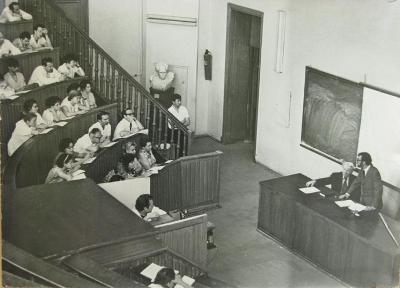Stories
The physiology of Nickolai Bernstein
Evolution of
the brain
and social behavior
Learning languages
* * *
When I took the job as Assistant Professor of Psychology at Wesleyan in the fall of 1970, I began immediately to design and teach two courses, Evolution of the Brain; and Evolution of Social Behavior.
For 22 years I taught these courses almost every year, updating them annually and keeping careful notebooks, which I still retain, along with the syllabi and the original scientific publications that the students were expected to read. On another page I describe the methodology that I used in teaching. I planned to use the content of these courses for two textbooks, but I never got around to writing them, and as far as I know, nothing like them has ever been published. The closest I came were the lectures I gave in Soviet Georgia in 1980, of which I still have hand-written copies in my publications file at home.
Evolution of the Brain was taught eight times from 1972 to 1982 and in the last year the outline consisted of the following:

Lecturing at Tbilisi State University, Soviet Georgia, in 1980
Introduction - Evolutionary Perspective
Section 1 - Basic Neurophysiology and Neuroanatomy
Nerve impulse and synapse
Section 2 - Spinal cord, hindbrain and vertebrate locomotion
Single neurons and behavior
Neuroanatomy
Spinal cord
Section 3 - Sensory systems
Basic design of vertebrate brain
Evolution of brain size
Brain mechanisms of directional control and stabilization
Postural systems
The cerebellum
The neocortex
Audition in the frog
Section 4 - The forebrain
Audition in man
Visual reception
The retina
The evolution of the eye
The optic tectum of the frog
The optic tectum of the mammal
The visual cortext of the mammal
Olfactory mechanisms and functions
Olfactory and limbic pathways
Brain mechanisms of feeding
Brain mechanisms of spatial orientation
A motivational systems analysis

Lecturing at the First Moscow Medical Institute in 1973. With me is
Pyotr Anokhin. The hall is the Sechenov lecture hall where Sechenov,
the great Russian brain physiologist, lectured in the 19th Century.
 |
Stages
1986-1992
Fall of Soviet Empire
1992-1997
UNESCO Culture of Peace Programme